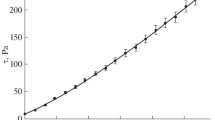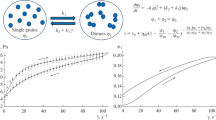Summary
Shear-thickening theology in steady shear occurs in concentrated dispersions (particle volume fraction more than 45 or 50%) over a narrow range of shear rates, outside which the behaviour is shear-thinning. Increasing the concentration in the shear-thickening region makes the viscosity rise more abrupt or even discontinuous; decreasing the concentration diminishes the shear thickening until shear thinning only is observed. To explain thinning followed by thickening with rising shear rate, at least two processes need to be invoked in addition to viscous hydrodynamic effects. These processes may relate to Brownian motion, inertia, particle deformability or interactions due to van der Waals, electrostatic or steric forces. Dimensional analysis shows which processes are most important for a given particle size and shear rate. The arrangement of the particles (random or orderly), which is influenced by the history of the sample, has an important effect on the theology. Equations to represent shear thinning and thickening behaviour are given; correlation of the constants in them with the results of the dimensional analysis may allow the theologically important processes to be identified.
Zusammenfassung
Das durch Scherung verdickende theologische Verhalten in stationärer Scherströmung erfolgt bei konzentrierten Dispersionen (Teilchenkonzentration pro Volumen über 45% oder 50%) in einem engen Gebiet des Schergradienten. Außerhalb dieses Bereichs findet das scherverdünnende Verhalten statt. Das Wachsen der Konzentration im scherverdickenden Bereich läßt die Steigerung der Viskosität steil oder selbst diskontinuierlich erfolgen; bei Verringerung der Konzentration nimmt die Scherverdickung ab, bis schließlich nur Scherverdünnung beobachtet wird. Um den Übergang Verdünnung zu Verdickung mit wachsendem Schergradienten zu erklären, muß man mindestens zwei Prozesse betrachten, zusätzlich zu den viskosen hydrodynamischen Effekten. Diese Prozesse mögen von Brownscher Bewegung, Trägheit, Teilchenverformung oder von der Wechselwirkung auf Grund von van der Waalsschen, elektrostatischen oder sterischen Kräften abhängen. Dimensionalanalyse zeigt, welche dieser Prozesse die wichtigsten für eine gegebene Teilchengröße und einen gegebenen Schergradienten sind. Die Anordnung der Teilchen (regellos oder geordnet), die von der Geschichte der Probe beeinflußt wird, hat einen wichtigen Effekt auf das theologische Verhalten. Gleichungen, die das scherverdünde und verdickende Verhalten darstellen, werden gegeben; die Korrelationen der Konstanten in diesen Gleichungen mit den Ergebnissen der Dimensionalanalyse können zur Identifizierung der rheologisch wichtigen Prozesse helfen.
Similar content being viewed by others
References
Osmond, D. W. J., I. Wagstaff, In: Dispersion Polymerization in organic media,K. E. J. Barrett, ed., pp. 243–271 (London 1975).
Vagstaff, I., Brit. Soc. Rheol. Autumn Conf., Norwich, 1973; Rheol. Abstr.16, 164 (1973).
Osmond, D. W. J., F. A. Waite, In: Dispersion Polymerization in organic media,K. E. J. Barrett, ed., pp. 9–44 (London 1975).
Jobling, A., J. E. Roberts, In: Rheology of Disperse Systems,C. C. Mill, ed., pp. 127–138 (London 1959).
Bauer, W. H., E. A. Collins, In: Rheology Theory and Applications,F. Eirich, ed., vol. 4, pp. 423–459 (New York 1967).
Severs, E. T., J. M. Austin, Ind. Eng. Chem.46, 2369 (1954).
Gunnerson, H. L., J. P. Gallagher, Ind. Eng. Chem.51, 854 (1959).
Riese, W. A., Farbe und Lack67, 632 (1961).
Gillespie, T., J. Colloid Interface Sci.22, 554 (1966).
Bjerke, O., In: Advances in Polymer Science and Technology, S.C.I. Monograph No. 26, pp. 370–380 (London 1967).
Krasheninnikov, A. I., R. A. Malakov, M. A. Fioshina, Dokl. Akad. Nauk.174, 402 (1967);Krasheninnikov, A. I., A. K. Stal'nov, V. N. Demishev, Kolloidn. Zh.35, 1165 (1973).
Shtarkman, B. P., I. A. Voronkova, V. M. Soldatov, Kolloidn. Zh.34, 276, 594 (1973).
Bubis, L. D., D. N. Emel'yanov, L. I. Myasnikova, Yu. V. Ouchinnikov, A. V. Ryabov, G. M. Chernova, Kolloidn. Zh.34, 757 (1972);B., O., R., andE., ibid.35, 528 (1973);R., O., E., B., andA. T. Pavlitsina, ibid.36, 399 (1974).
Hoffman, R. L., Trans. Soc. Rheol.16, 155 (1972).
Hoffman, R. L., J. Colloid Interface Sci.46, 491 (1974).
Metzner, A. B., M. Whitlock, Trans. Soc. Rheol.2, 239 (1958).
Trapeznikov, A. A., G. G. Petrzhik, T. I. Korotina, Dokl. Akad. Nauk.176, 378 (1967).
Morgan, R. J., Trans. Soc. Rheol.12, 511 (1968).
Pivinskii, Yu. E., Kolloidn. Zh.35, 286 (1973).
Barbee, J., Trans. Soc. Rheol.17, 413 (1973).
Krieger, I. M., Advan. Colloid Interface Sci.3, 111 (1972).
Dieterich, D., W. Keberle, H. Witt, Angew. Chem. Internat. Ed.9, 40 (1970).
Heine, K., D. Kranz, E. E. Schäfer, E. Schwinum, Angew. Makromol. Chem.27, 37 (1972).
Cheng, D. C.-H., Nature (London)245, 93 (1973).
Utracki, L. A., J. Colloid Interface Sci.42, 185 (1973).
Happel, J., H. Brenner, Low Reynolds Number Hydrodynamics (Englewood Cliffs 1965).
Goldsmith, H. L., S. G. Mason, In: Rheology Theory and Applications,F. Eirich, ed., vol. 4, pp. 85–250 (New York 1967).
Barsted, S. J., L. J. Nowakowska, I. Wagstaff, D. J. Walbridge, Trans. Faraday Soc.67, 3598 (1971).
Brenner, H., In: Progress in Heat and Mass Transfer,W. R. Schowalter, ed., vol. 5, pp. 90–129 (Oxford 1972).
Cross, M. M., J. Colloid Interface Sci.44, 175 (1973).
Doroszkowski, A., R. Lambourne, J. Polymer Sci.C34, 253 (1971); J. Colloid Interface Sci.43, 97 (1973).
Cairns, R. J. R., R. H. Ottewill, D. W. J. Osmond, I. Wagstaff, J. Colloid Interface Sci.54, 45 (1976); Ottewill, R. H., ibid.58, 357 (1977).
Evans, R., D. H. Napper, J. Colloid Interface Sci.45, 138 (1973);47, 269 (1974).
Cross, M. M., J. Colloid Sci.20, 417 (1965).
Cross, M. M., J. Colloid Interface Sci.33, 30 (1970).
Wagstaff, I., C. E. Chaffey, J. Colloid Interface Sci.59, 53 (1977).
Chaffey, C. E., J. Colloid Interface Sci.56, 495 (1976).
Schempp, W., W. Friesen, J. Schurz, Das Papier (Darmstadt),28, V1 (1974).
Layec-Rapbalen, M.-N., C. Wolff, J. Non-Newtonian Fluid Mech.1, 159 (1976).
Homola, A., A. A. Robertson, J. Colloid Interface Sci.54, 286 (1976).
Author information
Authors and Affiliations
Additional information
With 3 figures and 3 tables
Rights and permissions
About this article
Cite this article
Chaffey, C.E. Mechanisms and equations for shear thinning and thickening in dispersions. Colloid & Polymer Sci 255, 691–698 (1977). https://doi.org/10.1007/BF01550058
Received:
Issue Date:
DOI: https://doi.org/10.1007/BF01550058




